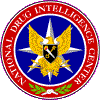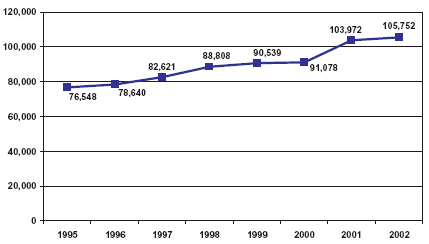 |
National Drug
Intelligence Center
National Drug Threat Assessment 2005 -
Executive Summary
February 2005
The diversion and abuse of pharmaceutical narcotics,
depressants, and stimulants are a significant threat to the United States. Rates of abuse for prescription
drugs have increased sharply since the early to mid-1990s but appear to be stabilizing at high levels. The
consequences of prescription drug abuse also have increased since the early to mid-1990s and have
continued to increase during the past 2 reporting years.
Trends and Developments
-
The abuse of prescription drugs increased sharply since the
mid-1990s and now has stabilized at high levels. ED mentions of narcotic analgesics increased
nearly 300 percent from 1995 through 2002, and mentions of benzodiazepines increased 38
percent during the same period. From 1992 through 2002 treatment admissions for opiates other
than heroin increased more than 200 percent.
-
The availability of pharmaceuticals has increased since the
late 1990s when legitimate production of pharmaceuticals increased sharply, making more
pharmaceuticals available for illegal diversion.
Figure 11.
Emergency Department Mentions for Narcotic Analgesics,
1995-2002

d-link
Source: Drug Abuse Warning Network.
Figure 12.
Emergency Department Mentions for Benzodiazepines, 1995-2002

d-link
Source: Drug Abuse Warning Network.
To Top To
Contents
- The trafficking and abuse of GHB (gamma-hydroxybutyrate)
have become a particular concern to law enforcement and public health agencies because of
increasing availability of the drug in some areas, sharp increases in ED mentions for GHB since the
mid-1990s, and the use of GHB in the commission of drug-facilitated sexual assault.
- Rates of ketamine use are trending downward among
adolescents and young adults. In addition, seizure data indicate that ketamine availability is decreasing
and that ketamine-related ED mentions appear to be trending downward.
- The availability of LSD (lysergic acid diethylamide) is
decreasing, and rates of use have decreased sharply to very low levels.
- The consequences of PCP (phencyclidine) use are increasing
despite relatively stable or declining past year rates of use. The estimated number of ED
mentions for PCP increased each year from 1998 to 2002.
To Top To
Contents
- Analysis of long-term trends in inhalant abuse among
adolescents reveals that rates of abuse declined overall from 1995 to 2002; however, abuse among eighth
graders rose significantly from 2002 to 2004.
To Top To
Contents
To Top To
Contents
Interagency estimates indicate that the cost to society from
drug trafficking and abuse in the United States is between $60 billion and $108 billion. In 2000, the
most recent year for which these data are available, the Office of National Drug Control Policy
(ONDCP)
estimated annual retail-level cocaine purchases at $36 billion, heroin at $10 billion, marijuana at
$11 billion, methamphetamine at $5.4 billion, and other substances at $2.4 billion. These figures do not
include the estimated dollar figure for drugs purchased at wholesale or midlevel, meaning that the
amount of drug-related currency generated in the United States may be significantly greater than the $60
billion to $108 billion estimate.
Figure 13.
Estimated Annual Domestic Retail-Level Drug Purchases in Billions of Dollars,
2000

d-link
Source: Drug Abuse Warning Network.
Trends and Developments
-
The physical transportation of bulk cash and monetary
instruments is a principal method used by drug traffickers to move illicit drug proceeds from domestic
drug markets to other U.S. and foreign destinations. The primary origins of U.S. currency
seized between 2001 through 2003 were California, Illinois, New York, and Texas, while Arizona,
California, Florida, and Texas were the primary destinations.
-
Drug traffickers in the United States frequently use money
services businesses (MSBs)--particularly money transmittal, currency exchange (casas de cambio),
and check-cashing businesses--to launder drug proceeds. MSBs filed 214,966 Suspicious Activity
Reports (SARs) with the Financial Crimes Enforcement Network (FinCEN) from October 1, 2002, to
December 31, 2003. During that period, states with the most MSB-SAR filings were New York,
California, Arizona, Texas, and Florida.
-
Drug traffickers, particularly South American traffickers,
launder illicit drug proceeds through informal value transfer systems (IVTS). For example, South
American traffickers launder an estimated $3 to $6 billion each year through the Black Market
Peso Exchange (BMPE). Southeast and Southwest Asian traffickers also launder and transfer large
amounts of money through
hawala, hundi, or hui khan IVTS. Unlike the BMPE,
however, hawala, hundi, and hui khan businesses can operate legally in the United States, provided
that they register with the FinCEN and comply with all applicable laws, such as the Bank
Secrecy Act. The registration requirement was established by the USA PATRIOT Act of 2001 and
makes it easier for government agencies to prosecute individuals laundering drug proceeds
through these systems.
To Top To
Contents To
Previous Page
To Publications Page
To
Home Page
|
![]() To Contents
To
Previous Page To Publications Page
To
Home Page
To Contents
To
Previous Page To Publications Page
To
Home Page
